Spotlight on Aaron Lavinsky
Apr 11, 2016
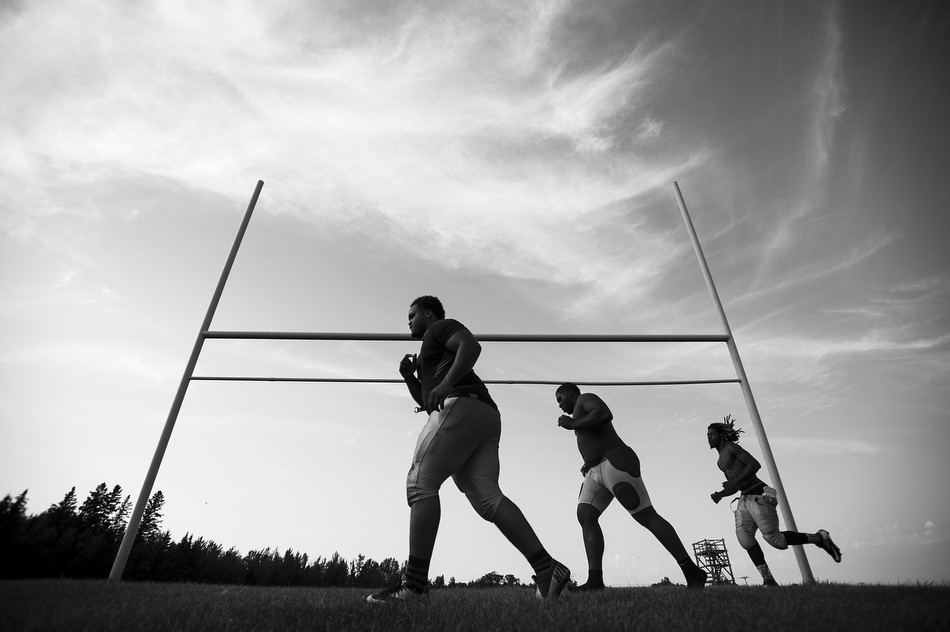
TID:
This image, and the surrounding images, are from a lovely and intimate body of work. Can you please tell us of the backstory?
AARON:
First off, thanks so much for the opportunity to share this work. I’ve been a fan and follower of The Image, Deconstructed since I returned to school to study journalism.
The story itself is about the 44 young men, mostly African American, who were recruited to play football at Mesabi Range College in Virginia, Minnesota, a mostly-white and economically depressed taconite mining town almost four hours north of the Twin Cities. All but two of the players are from outside the town and come from some pretty rough areas around the country. These student athletes either didn't have the academic skills or chops on the field to make it into a Division I or II NCAA program, so moving to Virginia to play football at Mesabi is a last chance for them to improve enough to continue playing football at a higher level.
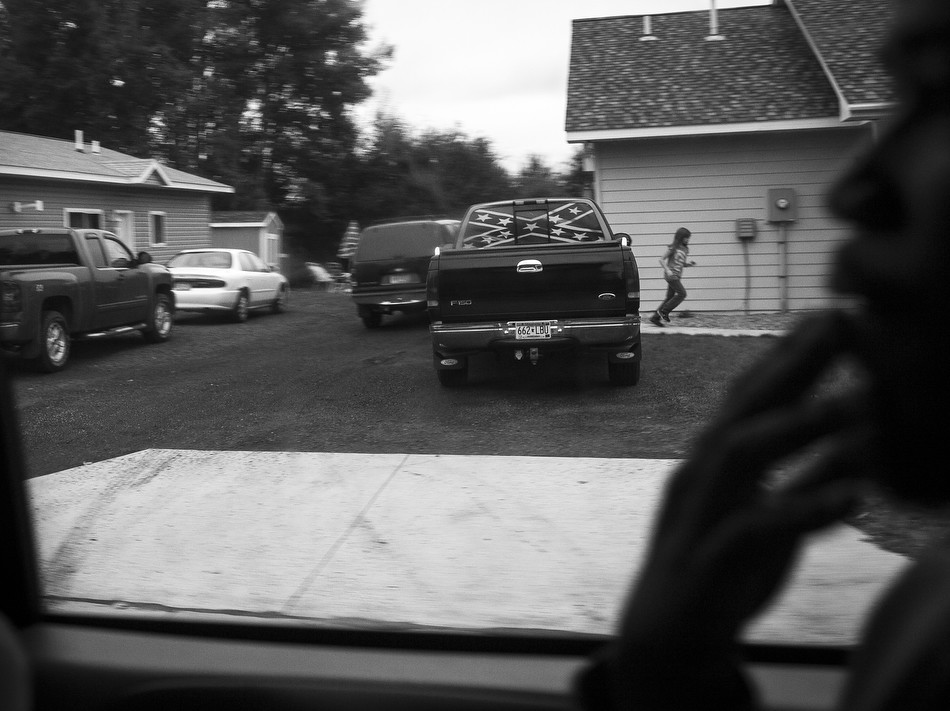
Many still harbored the dream of playing in the NFL one day, but the experience of playing at the lowest level of collegiate athletics, on a losing team, in the middle of nowhere, is a sobering experience. Many of the kids either go home after the season ends, or refocus their attention on seeking an associates degree before continuing on with their higher education.
Here's a link to the story if you're interested in reading more here: http://www.startribune.com/mesabi/334160481/, or viewing a multimedia link here: https://vimeo.com/162409180. I was fortunate to work with Mike Kaszuba, who is a hell of a reporter. It was his last story before retiring after more than 30 years here at the Star Tribune.

TID:
This project involves a lot of logistics/planning? Can you talk about your initial stages?
AARON:
Early on, I kind of just winged it. I didn’t know the area at all. I had never worked with Kaszuba. I wasn’t the one who was in contact with the coach, who really helped orchestrate the entire project. I kind of felt like I was just along for the ride.
I did however know there were certain key moments I wanted to document; the first game of the season, the first day of class, a late-season game. I was able to work with my editor, Tom Wallace, to make sure I had the time and resources to get up there to cover those important landmarks in the season and semester.
After the first trip though, I knew three visits wouldn’t be enough. The Wednesday after we returned from trip one, Kaszuba told me that the team was planning on having a picnic with a local Presbyterian church and I knew that photographing that would be critical for establishing a sense of place, and showing how out of place the young men were in the town.
A few days later, I was back up photographing the picnic and it allowed me to capture my favorite image from the project.
Mike Kaszuba and I worked very closely throughout the entire process. He noticed things I didn’t, like a confederate flag on the back of a truck right near the school, that some of the students passed by almost every day when they drove off campus. I then made it a point to try to tag along with some of the students until I made a photo of the flag through their car window that worked. Mike also told me about a team tradition, in which the students walked to their home football games through the neighborhood between the school and the high school football field they play on. I made a trip back up to Virginia just to make that photo, which ended up being the main image on the double truck.
The longer I worked on the story, the more I felt like I needed to shoot and towards the end, I really felt like I had to pitch specific moments in order to get the time to go back up north. Luckily, my editors agreed and allowed me to do what I needed to do.
TID:
This body of work has a classic documentary feel to it (intimate and behind the scenes). Once you got your footing, how did you move forward mentally (versus at the beginning)?
AARON:
The first trip was critically important for building relationships with the students we were documenting. We were with them pretty much all day for the first few days, from morning practice until after dinner. A few of the guys thought we were doing some sort of TV, ESPN story and I had to emphasize that we were there to work on a story for the Star Tribune in Minneapolis, a newspaper which nobody I talked to from the team had heard of with the exception of the handful of guys from Minnesota.
They didn’t seem to mind the attention of having a photographer follow them around all day and I quickly earned the nickname, “Mr. Photographer.” I’d say a real coup took place when I spent a good half-day with some of the guys as they did social, non-football related stuff. We went to a local swimming hole between two-a-day practices and then went out to a dive bar to get dinner later that night. I wasn’t quite as decked out with camera gear, like I was earlier while covering their practice, and I spent most of the time chatting with the guys over beer and wings. The team captains were there and once I had established a relationship with them, I was in.
Almost all of the team lived on campus, so I’d just go knock on doors and see who was home and ask if I could hang out for a bit and take pictures. I wasn’t turned down a single time. Sometimes they’d be sitting around playing video games or doing absolutely nothing. One time there was a pretty serious argument between roommates and I was in there shooting away without anyone saying a thing. I very quickly became a fly on the wall, which made my job there a lot easier. Aside from the occasional photo bomb, which is to be expected when being with guys that are in their late teens and early twenties, there was pretty much no issue with camera awareness. This allowed me to try to make more complex images than I think I’d be able to make otherwise.
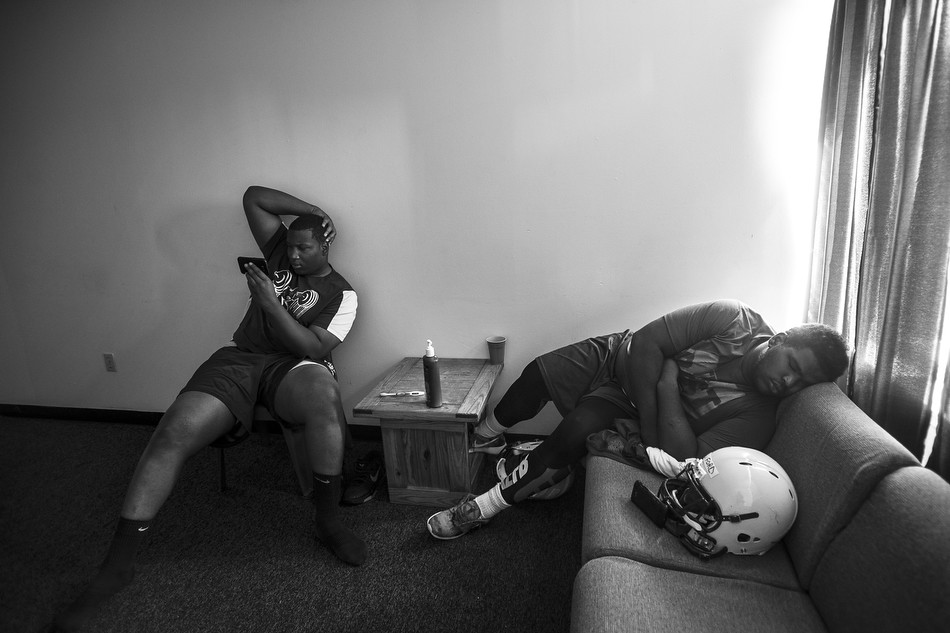
TID:
Documentary work always includes problems that emerge. What problems did you encounter and how did you overcome these problems?
AARON:
The largest hurdle to overcome in the project was definitely trying to visually tie the team to the town. There wasn’t a whole lot of natural interaction between the guys on the team and locals and very few people from the town attended their games or team activities, which was a large part of everyone on the team’s lives. There is also really no nightlife in town to speak of, which is where I might have expected to see a genuine experience of a 20-something year old guy play out in a typical college environment.
A lot of the story, to me, was “wow, there is really nothing to do for young men in this town.” It turns out that boredom and a lack of things happening is challenging to photograph. I was always racking my brain in terms of how I could show our readers the tepid relationship between the team and the community in which they are a part of, but not necessarily trying to fit in with. A colleague of mine, Brian Peterson, looked through some of my work and suggested I try to get into someone’s home and photograph the team walking to one of their home games through their window, while the inhabitants of the home went about doing their thing. I tried to do this and nobody from the two houses that would have worked for the picture would let me into their home because of either scheduling issues or because they didn’t want to have anything to do with the story, which was understandable.
So I found that the solution was just to document everything I had access to and eventually, things would just come together. Luckily, I was given quite a bit of time to work on the project and I feel things came together and I got the moments I was looking for when I look through what I’ve got now. I was never quite happy with what I shot after each trip, and I think that pushed me to try to outdo myself for the next trip and I think that mentality paid off. I ended up having a lot of options for certain storytelling moments that at the time, I thought would be almost impossible for myself to illustrate.

TID:
By in large, how did people receive your presence?
AARON:
There were definitely mixed reactions, especially when dealing with a team made up of 44 people. Some people were instantly accepting, others didn’t seem to quite know why I was so interested in getting access to their personal lives off the field - especially if I’m there to work on a football story. Everyone was very friendly though, and some of the guys became very familiar with Mike and I. They would see us getting ready to leave and would hitch a ride in our car and have us drop them off in town at a restaurant or gas station. I think a lot of that comes from the kinds of environments these guys came from. We were happy to give them a lift.
People in town seemed very interested in what we were doing. We were from the “Star & Tribune,” from the Twin Cities. We do cover a fair amount of the happenings up on the Iron Range when it comes to the mining industry and unions, but people didn’t seem accustomed to seeing and talking to reporters from the Star Tribune and thought we must be working on some kind of big story to travel all the way up there. When we told them it was about Mesabi Range College’s football team, there was definitely a sense of bewilderment. “Why is the Star Tribune covering a team in Virginia with virtually no local guys and a poor record?” Still, everyone was very pleasant to us. “Minnesota Nice.”
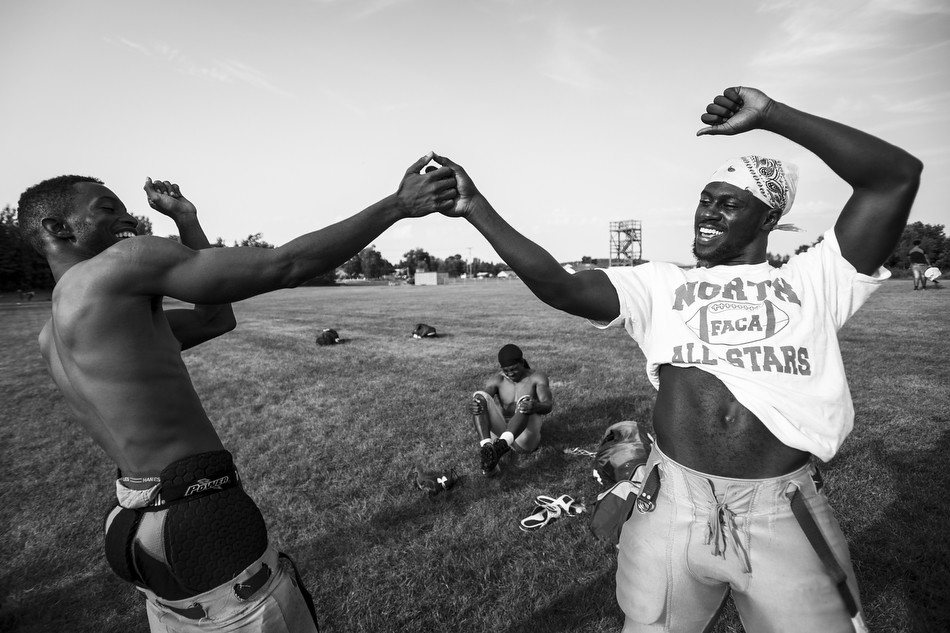
TID:
What do you think you did well (that you'll carry forward next time into the next project)?
AARON:
One of the things I was a bit nervous about when I first started the project was balancing the need for both still photography and video. They both require a different mentality and a different gear set, so when dealing with a sports project, it was a bit of a logistical challenge switching back and forth between the two, especially dealing with long lenses, tripods, audio, etc. I really had to identify my goals for each medium and make sacrifices, knowing that I could either get a moment in one medium or the other. This project helped me organize the needs for the different forms of storytelling and I think that led to a well-rounded, finished project.
Shooting stills and video for a project will always be hard, but I think I was able to prove to myself that I can do it. I’ve always felt that when you’re shooting both photo and video, one or both mediums will suffer from juggling the two, but I don’t think this project suffered from that fate and I’ll remember that moving forward to the next project.
TID:
You’ve relatively young in the profession, no? What have you learned about yourself as it relates to the photographic journey?
AARON:
When it comes to this story, I’ve learned to be patient. I’ve been pretty deep in the daily grind for the past few years, covering sports, portraits and general news most of the time and am usually on a deadline. Having this much time to work on a project and this much attention from a team of editors and designers back in the newsroom really pushed me to find the right pictures to tell the story. I’m trying to bring that patience to my daily work while trying to shed the neuroticism of thinking I might miss the shot, or that it’s not as good as what my colleagues might shoot.
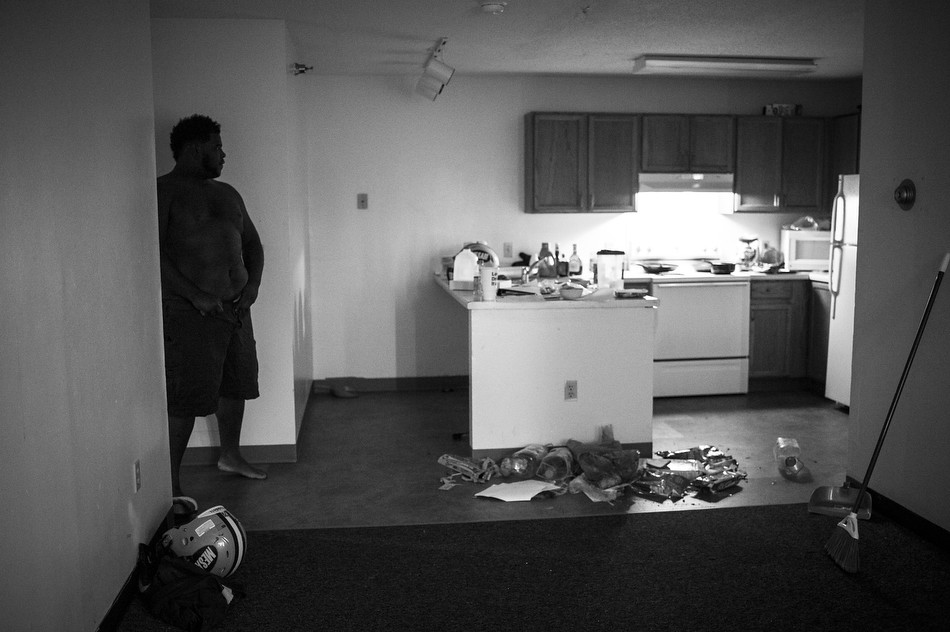
When it comes to my general outlook on photojournalism and photography, especially in a newspaper environment, I’ve learned to pitch stories to and build relationships with reporters you like to work with. While I don’t have my own photo column like he does, I’ve always admired Alan Berner at the Seattle Times and his column, “Northwest Wanderings.” He finds the story, he shoots it and writes it, and he always seems to be somewhere interesting making pictures that he wants to make. I’m not sure I’m ready to take on all of those responsibilities yet, but I can certainly keep my eyes out for fun stuff, like a unicycle hockey league, a cat show, or a club made up exclusively of women named Lois, to photograph. I’m sure I’ve dodged a decent number of business portraits by being out there shooting stuff I find on my own.
TID:
What did you learn about others?
AARON:
I’ve learned that there are people who are naturally accepting of what we try to do as photographers, and as people. I doubt that everyone I photographed understood what I was doing there, but that didn’t stop them from letting me into their lives to photograph intimate moments. That was refreshing, given the climate I’ve encountered here in the Twin Cities when I photograph people in public.
It was also fascinating seeing what a sports team is like without a PR machine breathing down your neck as a journalist. There are high school hockey and football teams here in the Twin Cities that would never let a photographer and reporter have this kind of access to their team. Division I NCAA sports? Forget it. Pro sports? Not a chance. Mike and I knew that the access that head coach Dan Lind granted us was precious, and I hope we did justice to the coach and student athletes with the story that was published.
TID:
In conclusion, what advice do you have for photographers wanting to do this type of work?
AARON:
Be passionate. Be patient. Be curious. Make sure you’re the story’s biggest advocate.
:::BIO:::
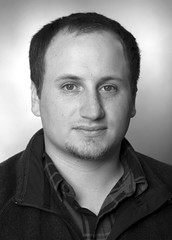
Aaron Lavinsky is a staff photographer on general assignment at the Star Tribune in Minneapolis. Before moving to Minnesota, Lavinsky worked as a photographer for The Daily World in Aberdeen, Washington and also interned with the Arizona Republic and the Seattle Times. He attended the Eddie Adams Workshop in 2014. Lavinsky’s work on the Mesabi Range College football team was recognized by the National Press Photographer Association’s Best of Photojournalism competition in the photography, multimedia and editing divisions and he was named Arizona’s College Photographer of the Year in 2012. When he isn’t working, Aaron enjoys, camping, fishing and letting his overweight cat, Pixel, distract him from editing.
You can follow Lavinsky’s work on Twitter and Instagram at @ADLavinsky or on his website at: www.aaronlavinsky.com